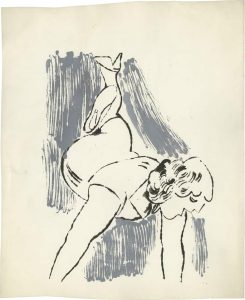Month: May 2012
June 12, 2012 — June 17, 2012
And as Warhol was a man of few words, his drawings speak: in praise and eloquence of his world, the gaudy rush of images he must have assimilated, arriving in New York from the dark and smoky depths of Pittsburgh. And what results is reactive, he just cannot draw enough. He observes, records and stages – much in the way he dresses windows, the ongoing play of life and its actors. And until he grasps the Polaroid – another direct tool of observation, the hand and the pencil work ceaselessly. And the mass of images produced by 50s and 60s glossy magazines streams by. The weeklies became a window to the world and its frenzy. As Weegee and others constantly pounded the streets at night, a whole new universe and dramatis personae emerged. High society collided with street life, and the inner workings of the big city emerged on shiny sheets, the flash bulb catching its subjects, their eyes pinned in surprise, as an animal caught in the headlights of an oncoming vehicle. This is the locale, Andy’s motif where day and night were inseparable landscapes, and endless fodder for his eager hands…
Quote from the catalogue essay by Sydney Picasso
Art Basel
Stand 2.0 | D8
Opening: 12/13 June
Exhibition: 14 – 17 June

July 6, 2012 – July 28, 2012
With NOW! we present an exhibition of vintage 20th century press prints.
We focus the exhibition on events, on stop-the-press snapshots that not only document but define history. There is no motion, only moments in quick succession, and in an age of media saturation we are quick to look at and dismiss newspaper stories and photographic coverage of events, not because images aren’t interesting or important, but because there are too many of them.
The prints in the show are vintage, meaning they were printed at the time when the photograph was originally taken. Most prints are analogue wire- or radio-transmitted images. The resulting hardcopy prints were used for the creation of magazines or newspapers, and were later stored in news archives. Many of the prints have ink stamps and news clippings on the back, and some display airbrushing or crop marks on the front. They have themselves collected history, and over time have borne witness to vast global change and upheaval.
These prints are thus testimony to the events of the past and reliquaries for our changing beliefs. They are valuable due to their status as historical documents, but everyone should be able to own a part of history and their affordability reflects this ideal.
Please join us for the opening of this exhibition on Thursday 5th July from 6 – 9 pm at 51 Hoxton Square.
June 1, 2012 – June 30, 2012
Daniel Blau Ltd. is pleased to present a unique collection of nineteenth century cyanotypes by Georges Poulet, in the first exhibition of its kind in the UK.
French engineer Georges Poulet’s (1848 – 1936) photographs of railway construction in Argentina convey a sense of the pioneering spirit characteristic of the nineteenth century. These cyanotypes depart from customary notions of documentary photography, taking the viewer on an intensely atmospheric journey through the largely unspoiled Argentina of the late nineteenth century. They also reveal a desire to record technological progress in an artistic way. The mysterious blues produced by the cyanotype process create a special ambience, while the captions written elegantly in red ink at the bottom of each photo provide an element of narrative and of contrast.
Scientist Sir John Frederick Herschel invented the cyanotype (more commonly known as the blueprint) in the early days of photography. Engineers and architects used it to reproduce technical drawings, maps and so forth; but artists also employed the technique and its influence is evident in their work.
Poulet employs the advantages of the cyanotype medium: its ability to reproduce reality, and the blue that is an integral part of it. Blue, of course, has a metaphorical dimension, symbolising longing for far-off places. In one of those distant regions we encounter the subject of Poulet’s series of cyanotypes: full of yearning, he shows us the railway in Argentina as in a dream, flooded in a melancholy blue.
Please join us for the opening of this exhibition on Thursday 31st May, 2012 from 6 – 9 pm at 51 Hoxton Square.
Abridged text from “Aurora Argentina”, an illustrated publication accompanying the exhibition and containing a complete catalogue of Poulet’s Argentinian cyanotypes.





 +49 89 29 73 42
+49 89 29 73 42